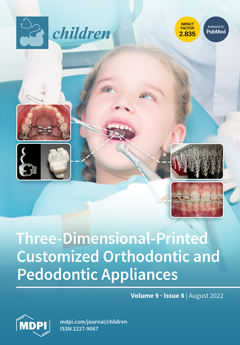Background: Pediatric minimally invasive surgery (MIS) is a standard technique worldwide. We aimed to analyze the research activity in this field. Methods: Articles on pediatric MIS (1991–2020) were analyzed from the Web of Science™ for the total number of publications, citations, journals, and
[...] Read more.
Background: Pediatric minimally invasive surgery (MIS) is a standard technique worldwide. We aimed to analyze the research activity in this field. Methods: Articles on pediatric MIS (1991–2020) were analyzed from the Web of Science™ for the total number of publications, citations, journals, and impact factors (IF). Of these, the 50 most cited publications were evaluated in detail and classified according to the level of evidence (i.e., study design) and topic (i.e., surgical procedure). Results: In total, 4464 publications and 53,111 citations from 684 journals on pediatric MIS were identified. The 50 most cited papers were published from 32 institutions in the USA/Canada (
n = 28), Europe (
n = 19), and Asia (
n = 3) in 12 journals. Four authors (USA/Europe) contributed to 26% of the 50 most cited papers as first/senior author. Hot topics were laparoscopic pyeloplasty (
n = 9), inguinal hernia repair (
n = 7), appendectomy, and pyloromyotomy (
n = 4 each). The majority of publications were retrospective studies (
n = 33) and case reports (
n = 6) (IF 5.2 ± 3.2; impact index 16.5 ± 6.4; citations 125 ± 39.4). They were cited as often as articles with high evidence levels (meta-analyses,
n = 2; randomized controlled trials,
n = 7; prospective studies,
n = 2) (IF 12.9 ± 22.5; impact index 14.0 ± 6.5; citations 125 ± 34.7;
p > 0.05). Conclusions: Publications on laparoscopic pyeloplasty, inguinal hernia repair, appendectomy, and pyloromyotomy are cited most often in pediatric MIS. However, the relevant number of studies with strong evidence for the advantages of MIS in pediatric surgery is missing.
Full article






